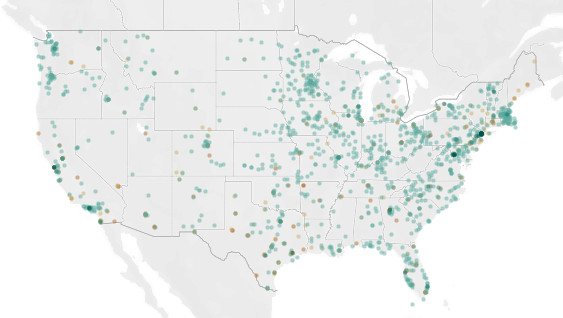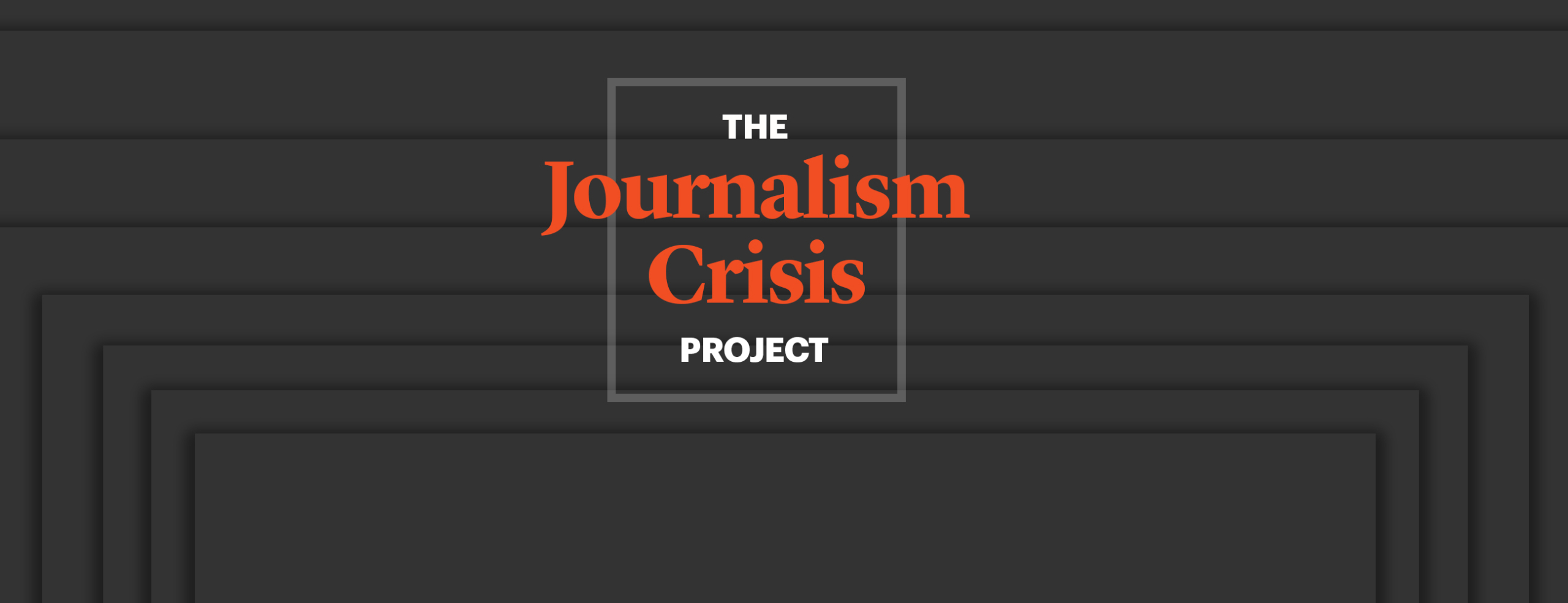Sign up for The Media Today, CJR’s daily newsletter.
Since March of 2020, the Tow Center for Digital Journalism has been collecting data on cutbacks to US newsrooms happening amid the novel coronavirus pandemic; today, they published the sum of their findings for the first time.
Over the past six months, researchers at the Tow Center have aggregated and vetted reports of layoffs, furloughs, closures, print reductions, and a wide range of cutbacks—depending upon news reports, Twitter announcements, press releases, and Google Form responses. “covid came along and accelerated what was already an incredibly awful time for local news,” says Pete Brown, research director at the Tow Center. He hopes the project can bear witness, cataloguing losses in a critical moment for journalism, tracking trends and patterns that can be studied as the industry and its supporters look for solutions to the crisis. “Here is as clear a picture as we can provide on how it happened, the rate at which it happened, how many people have been laid off in a given day, how layoffs affected different regions,” Brown says. “Down the line, to be able to systematically track what disappeared will be a useful resource in comparing the past to what eventually emerges in its place.”
The published map is a bleak sight—the United States news landscape riddled with a mess of holes: lost jobs, stilled printers, newspaper nameplates retired forever. And the startling image only hints at the true cost of the crisis: the gaps in knowledge that grow in the wake of the cutbacks, made particularly consequential in a year in which good and clear information can mark the difference between life and death.

The searchable database tracks the date on which a cutback was reported, the type of outlet, type of cutback, and—as much as possible—the number of staff affected and the geographic location of the outlet at which the cutback occurred. (Whenever a large media chain announced cutbacks, Tow researchers made note of every news outlet owned by the chain and added each to the database, labeling such entries as outlets “potentially affected” by cutbacks.)
The cutback tracker paints a grim picture, but it goes beyond that, providing contextual data points and interactive filters that turn a startling graphic into a searchable story. “We’re at the point in this crisis in which we need to start digging in to what those dots on the map actually mean,” says Gabby Miller, a research fellow with the Journalism Crisis Project. “Because the crisis is happening, whether we’re paying attention or not.”
Miller hopes that projects like this can both underline the need for solutions and provide a path to them. “People are starting to wake up to how bad this crisis is,” Miller says. “We need to know why the crisis is bad, how, and what we can do—to understand how it’s shaping our future.” It’s her hope—and ours—that this database can provide some keys to unlocking the answers.
The Journalism Crisis Project aims to train our focus on the present crisis, tallying lost jobs and outlets and fostering a conversation about what comes next. We hope you’ll join us (click to subscribe).
CONTRIBUTE TO OUR DATABASE: If you’re aware of a newsroom experiencing layoffs, cutbacks, furloughs, print reductions, or any fundamental change as a result of covid-19, let us know by submitting information here. (Personal information will be kept secure by the Tow Center and will not be shared.)
ATTEND OUR SYMPOSIUM: Join us on September 15 and 16 for a series of online conversations aimed at fostering fresh thinking about the media—considering how to rebuild the news industry after this season of loss. We’ll hear from some of the most urgent voices in the profession to talk about where journalism goes next. You can register here.
Below, more on changes in newsrooms across the world:
- STATE OF NEW JERSEY INVESTS IN LOCAL NEWS: Last week, New Jersey governor Phil Murphy proposed a budget that would include $550,000 for the New Jersey Civic Information Consortium, a project intended to provide state funding for local news organizations and projects, WHYY Radio reported. The proposed sum makes up just 10 percent of the initial budget promised, and board members told WHYY it would be used as a springboard to raise additional funds.
- FREE COMMUTER PAPER WON’T REINSTATE PRINT JUST YET: City AM, a free daily business newspaper in the UK, has pushed back its return to print as commuters are still slow to return to offices, Press Gazette reported. Staff have returned from furlough, however, and pay cuts have decreased slightly. “We look forward to being back in print at the start of October when we fully expect greater numbers of readers passing through stations and more certainty in the advertising market,” chief executive Jens Torpe told Press Gazette.
- LOCAL NEWS FAILS SMALL COMMUNITIES: For CJR, Letrell Deshan Crittenden and Andrea Wenzel wrote about the local news crisis as it extends beyond major cities and legacy media publications. Crittenden and Wenzel were following up on some of their research on community-engaged journalism when the pandemic hit. “This simultaneously amplified the need for reliable information, and exposed the disparities in access to it among BIPOC communities in small towns and suburbs,” they write. US journalism needs to reckon with how it has failed such communities in the past, and how it continues to do so, rather than trying to look for solutions to the financial crisis in old unsustainable models. As Crittenden and others argued in July, we need to reimagine a free press for the twenty-first century.
- UNIONS FIGHT FOR EQUAL PAY: As part of the struggle for more diverse newsrooms, unions are pushing for pay equity and transparency, Nieman Reports wrote last week. “Over the past four years, dozens of unions at news organizations across the country have conducted pay studies, proving what many had long suspected: Women and people of color often earn less than their white male colleagues,” Kristen Chick writes. And Parcast, a Spotify podcast production company that specializes in true crime, has unionized, The Verge reported last week. “We love making podcasts and are confident that our union will help ensure a sustainable, equitable future in our fast-changing industry,” the Parcast Union tweeted last week.
- TRIBUNE LOCKS OUT CAPITAL GAZETTE STAFF: On Labor Day, when the staff of the Annapolis Capital Gazette planned to stage a rally in protest of Tribune Publishing’s closure of their offices, the paper’s publisher locked them out after learning of the rally in advance, the Washington Post reported. In June of 2018, a gunman killed five Capital Gazette staffers in those offices. “We’re not going to let our newspaper be damaged anymore, and we’re not going to let it be closed down easily,” Gazette reporter Rachel Pace told Tom Jackman.
- FSP ENCOURAGES FASTER PAYMENT FOR FREELANCERS: For the National Writers Union, the Freelance Solidarity Project has called for publishers to adopt new payment policies in light of the pandemic, paying freelancers more quickly for assigned and published work. “In order for digital media to become a sustainable, equitable, and inclusive industry, its workers need fair and prompt compensation at every stage of their labor,” the organization writes.
- AUSTRALIAN NEWSWIRE ASKS FOR SUPPORT: One month after launching as a not-for-profit organization, the Australian Associated Press 2.0 is asking for reader support, The Guardian reported. In early August, after Nine Entertainment and News Corp pulled out as shareholders, investors and philanthropists intervened to save the wire service. A month later, it still struggles to remain viable, Amanda Meade and Anne Davies report.
- API OFFERS GRANTMAKING ADVICE: The American Press Institute has written about the ways in which the pandemic has unlocked new funding opportunities, outlining the elements of grantmaking that every news organization should know. “News and information’s central role in our current crisis has opened new possibilities for grants that prioritize community needs, promote equity, and measure success in terms of community outcomes and impact,” Lizzy Hazeltine writes.
- SOLICITING SUPPORT WITHOUT A PAYWALL: South African digital news site the Daily Maverick has gained thirteen thousand paying members over the past two years by asking for reader support instead of implementing a paywall, Digiday reported. Founder Branko Brkic told Digiday that a paywall forces readers to see themselves as customers making a pragmatic decision about investing in a product. “What we say with Maverick Insider is ‘help us actually make this possible for people who cannot pay,’ ” Brkic said. “ ‘Be part of something bigger, be part of something really beautiful. It’s an emotional decision.’ ”
- ZOOM COULD DISRUPT THE EVENTS INDUSTRY: Though some in the news industry have celebrated the opportunities available in moving events online, Rafat Ali, for Skift, calls Zoom “the Napster of the event industry,” drawing parallels between how the music-sharing internet software changed the music industry in the early 2000s and how video conferencing is changing the events industry. “All types of business event—conferences, trade shows, conventions—are in danger of their revenues streams [sic] of tickets, sponsorships, memberships, and other types of fees being eroded as the world gets used to digital formats and alternatives emerge,” Ali writes.
- GOOGLE LAUNCHES PERSONALIZED RADIO NEWS FEED: Google News has announced the creation of Your News Update, a radio news playlist personalized for each listener, streamlined to mimic the setup of a public radio broadcast, Wired reported last week. “Based on Google’s wealth of user data, your particular playlist might feature stories about sports teams you follow or—assuming you’re allowing Google to track your location—news from local outlets,” Boone Ashworth writes. “(Yes, it’s yet another service dependent on Google knowing as much about you as possible.)”
- MAKING PODCASTS PROFITABLE: For What’s New in Publishing, Esther Kezia Thorpe writes about eight different ways publishers are monetizing podcasts—from dynamic, targeted advertising to sponsored series to subscriptions. Despite being a relatively new medium, Kezia Thorpe writes, podcasts are making strides in profitability.
- APPLE TO THROW A WRENCH IN TARGETED ADVERTISING: Apple announced plans to delay its requirement that users authorize apps to track them for advertising purposes, Joshua Benton reported for Nieman Lab. “Some publishers worry that most users will opt out, hobbling their ability to show personalized ads in apps and dealing them a blow at a time when the industry is trying to recover from the coronavirus pandemic,” Lukas I. Alpert and Patience Haggin write for the Wall Street Journal. The situation would likely advantage those publishers that sell advertising space directly, Benton writes. Apple’s delay has given publishers time to plan for the change.
- MORE LAYOFFS, CLOSURES IN THE UK: Scotland-based publisher DC Thomson shut down five magazines, eliminating nearly twenty positions, Press Gazette reported. UK-based local news publisher JPI Media announced thirty job cuts and reopened itself for sale, the Gazette reported. And Gizmodo UK and Kotaku UK announced closures of their digital sites.
JOURNALISM JOBS AND OPPORTUNITIES: MediaGazer has been maintaining a list of media companies that are currently hiring. You can find it here. The Deez Links newsletter, in partnership with Study Hall, offers media classifieds for both job seekers (at no cost) and job providers. The Ida B. Wells Society announced that its micro-loan program for journalists would no longer require recipients to repay their loans—you can apply here and donate here. The Successful Pitches database offers resources for freelancers. And the International Journalists Network lists international job opportunities alongside opportunities for funding and further education.
Has America ever needed a media defender more than now? Help us by joining CJR today.



